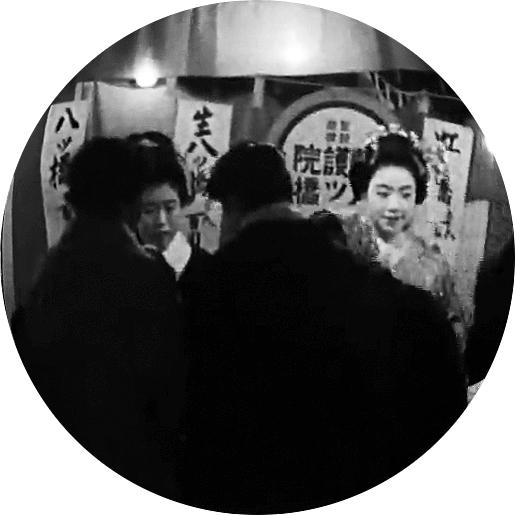Documentary Film Screening “Japan Rediscovered – Kyoto & Fukui Prefectures”
2016.07.08
ACADEMIA
Date & Time: Friday, July 8, 2016 6:30 p.m. (expected to end at 7:45 p.m.)
Venue: Intermediatheque 2F Lecture Theatre ACADEMIA
Admission free (no reservation required)
Language: Japanese (no subtitles)
The number of seats limited to 48. We request your comprehension.
* Photographing, filming and recording are strictly prohibited.
* Please refrain from eating and drinking in the museum.
【Screened Films】
“Kyoto Prefecture” (From the Japan Discovered series)
1961 / 28 min 47 sec / Digital version of original 16mm film / BW
Produced by Iwanami Film Production Co. / Producer: Takeji Takamura / Director: Isao Jinba / Scenario: Junpei Yoshihara / Camera: Yuji Okumura
“Kyoto Food”
1960 / 17 min / Digital version of original 16mm film / BW
Produced by Iwanami Film Production Co. / Producer: Teizo Oguchi / Director: Noriaki Tsuchimoto / Scenario: Susumu Hani, Hideyuki Inubushi, Junpei Yoshihara / Camera: Kazuhiko Shimizu
“Fukui Prefecture” (From the Japan Discovered series)
1961 / 28 min 55 sec / Digital version of original 16mm film / BW
Produced by Iwanami Film Production Co. / Producer: Takeji Takamura / Director: Takashi Fujie / Scenario: Junpei Yoshihara / Camera: Sin Kwang Woo
Kyoto and Fukui Prefectures, with all their historical heritage as well as their agricultural and pre-modern industrial past, were striving for a proper way to modernize after the war. While large-scale textile industries were spreading as a major regional economic actor, people worked to develop tourism and specialties deeply rooted in local history. The present screening will focus on this Quarrel of the Ancients and the Moderns in the development of this famous touristic region.
【On "Japan Rediscovered”】
From 1961 unto the following year, the educational series "Japan Discovered” presenting each region of Japan was broadcast on Nihon Educational Television. Produced by Iwanami Film Production Co., the series was filmed by major directors of the era, and offers a sociologic perspective on postwar Japan as it undergoes rapid economic growth. This is not to say that the series is simply an outdated educational material. Not only is it characterized by calm but poetic narration, as well as experiments on framing and editing which are common to the feature films of the same era, but it also offers a unique portrait of Japan at the time. The particularities of each region, but also the faces of the Japanese before they underwent globalization, and the landscapes of Japan as it is transformed by industrialization, are admirably recorded.
Starting in 1957 and for ten years, artist Taro Okamoto traveled Japan as it underwent rapid economic growth, visiting sites of memory representative of Japan, in the continuation of his quest for what he saw as Japanese traditions. He collected the photographs he took then, accompanying them with his own texts, and eventually published Japan Rediscovered. This series of documentary films constituting the first episode of our "Archaeology of Image” cycle is precisely Japan Rediscovered in its filmic version.
Organization: The University Museum, the University of Tokyo + Centre for the Conservation of Documentary Film
Cooperation: Yoshimi Laboratory, Interfaculty Initiative in Information Studies, the University of Tokyo
Program Conception: Intermediatheque Department, The University Museum, the University of Tokyo
【On "The Archaeology of Image”】
Since the invention of film, a colossal amount of documentary images ranging from educational films to news programs have been produced. Nowadays, these are instantly reproduced, edited and shared, as if this were an evident process. However, as far as their conservation and access to the public are concerned, the images constituting this colossal documentary corpus have not been treated equally. Among them, historical images everyone has seen form a tiny minority, and most documentary films have now fallen into oblivion. One of the main reasons accounting for this is the fact that most films having been commissioned, they were neglected or even destroyed just like consumable goods, once their initial function was fulfilled.
As far as it activates objects from the past in order to produce new interpretations for the future, this cycle of projections is particularly significant. By excavating, collecting, preserving and digitalizing film which records human activity throughout the 20th Century, and by showing it to the public, we can preserve part of the colossal image heritage in danger of extinction. At the same time, through documentary films diverging from the mainstream images we have been used to watch, we can reevaluate the evolution of 20th-Century Japan.
The Intermediatheque constantly produces new resources by preserving and reevaluating academic heritage in all its diversity, from scientific specimens to furniture, part of it was abandoned. For images alike, through an archaeological excavation of a corpus which is a trove of filmic memories of the 20th Century, we expect new discoveries.
The present cycle of projections will be held regularly, with the cooperation of the Centre for the Conservation of Documentary Film.

